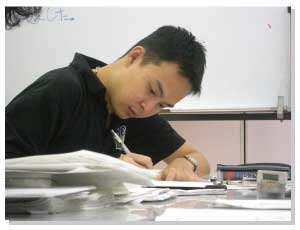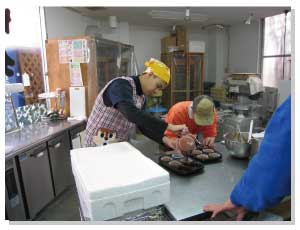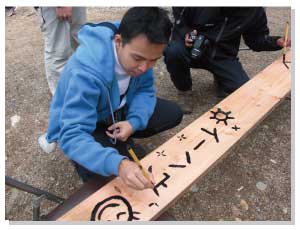- HOME
- Alumni News
- Yee Haw Heng (10th trainee)
- Yee Haw's Final Report
Yee Haw's Final Report
By opening my heart, I received a positive experience & growth from Japanese people
Coming to Japan for the first time
It was the first time for me to be abroad in my life. I arrived at Kansai International Airport on September 4, 2009. A ground staff at the airport guided me to register my passport and to complete other procedures. I was surprised because he was able to communicate with me by using Japanese sign language. Then I met other Duskin trainees, from different countries, with different religions, and with various different disabilities. I felt anxious when deaf Japanese people talked to me by using Japanese sign language because I did not know how to communicate with them. By the way, I was very surprised when I saw many Japanese people in poverty, who did not have a home and slept on the streets in Tokyo. I had always believed that Japan was a rich country and the standard of living high, so it was hard for me to believe that there were homeless people in Japan.
Japanese writing & Japanese sign language class in the first three months
I studied reading and writing in Japanese for the first time in my life. It was very difficult to understand. Sometimes I hated studying it. It was taught by three female teachers. They were very patient and offered strong support with encouraging me. I felt my spirit grow stronger and concentrated on study until my Japanese writing improved. I was able to read Japanese paragraphs of about 100 words including Kanji. Regarding Japanese sign language, I seldom used Malaysian sign language with the deaf Japanese teachers. They said it is forbidden to use Malaysian sign language during class. I must keep Malaysian sign language in a box and keep it closed. I also concentrated on learning Japanese sign language. It was not just an opportunity of enhancing friendship with deaf Japanese people by .using Japanese sign language, but also very interesting experience. After three months, I managed to improve my Japanese sign language.

Home Stay
I spent the period of 8 days at Mr. Akio Suemori’s house in Tsukuba during the New Year’s holidays, which was a home-stay program. He was deaf and had four family members including himself. I was really excited and curious about staying with them. Mr. Suemori was able to use the American sign language and finger spelling. We always had a conversation using Japanese sign language. It was wonderful to learn and know about the deaf culture, Japanese culture & history, food and other subjects. We talked about differences between Japan and Malaysia. His home has a cat and a dog. I really enjoyed patting a pet.
Skiing
In January 2009, I went to Niigata with all other Duskin trainees and staffs. We stayed there for 4 days 3 nights. I was very excited to see real, beautiful white snow covering the mountain. The first time I tried to touch the snow, it felt like a fridge. I saw that a Duskin trainee in a wheelchair could ski with specially modified skis. It is convenient for physically disabled people. At the beginning, I went up the mountain with an instructor by a chair lift. I was afraid when I saw how high the life was up and how deep it went into the forest. Then she taught me how to walk with skis. After a few hours, I was able to ski by myself. Sometimes I fell four times when the speed picked up. But it was so fun and I enjoyed it very much.
Individual Training
1. NPO Japanese ASL Signers Society
I received training at Japanese ASL Signers Society for one month. I studied how to prepare a basic presentation using PowerPoint and wrote a weekly report in Japanese. It was very challenging and difficult. I made many mistakes in the Japanese weekly reports. My Japanese was not good enough to describe the detail such as feelings, thoughts and behaviors. I did not have time to go out to have fun for a whole month. I always had rehearsals before the real presentation. Ms Takakusa gave me some advice. I learned my weak points, so that I could solve these weaknesses and problems by myself. She was very strict to me during the training. It meant I also had to be prepared for a better presentation. After the rehearsal, I was happy because my presentation skills were improved and I was able to answer questions if deaf Japanese people asked me any.
2. NPO Deaf Net, Kagoshima
I received training at NPO Deaf Net, Kagoshima and stayed there for a month. Ms. Rie Sawada was a deaf person and the president of the NPO. She was proud to have established the first NPO of the deaf people in Kagoshima. It was good for me because I learned a lot of things from her which made me feel positive. There were sign language classes, day-care center of deaf children and bakery shop where deaf people baked and sold cupcakes. I participated in these programs. I also taught deaf children Japanese sign language for the first time. I showed pictures to the students and asked them to create a story, from which students learned about body movement, facial expressions and Classifiers (CL). The deaf teacher said it was a very good method of storytelling.

3. Fukuro no Sato (A care house for deaf people)
I stayed at deaf old home in Awaji-shima for a few days. I was a volunteer to take care of old deaf people. At first I was not comfortable when helping old deaf men group together to take a bath and go to Onsen. But it was a real experience. The facility was very convenient with an elevator, television, toilet for wheelchair and others. The people told me that it was very nice and comfortable to have a conversation with each other. In Malaysia, there is no facility for old deaf people as a home. I was surprised and admired a deaf man who was 94. He was able to have conversation, walk, bathe and eat by himself.
4. National Rehabilitation Center for Persons with Disabilities
As of July 2, 2009 there are 2,300 registered sign language interpreters in Japan. But there are only a few who can do sign interpretation in Malaysia. I spent a period of 2 weeks for training at National Rehabilitation Center for sign language and interpretation, to learn basic techniques and systems of teaching by sign language. Mr. Satoshi Osonoe explained the sign language (e.g. vocabulary, phonetics & grammar). Mr Osonoe taught me, not only sign language teaching, but also linguistic knowledge about sign language and I came to understand that this type of knowledge was also crucial for those teaching sign language. At the end of the training, there was a mock class where I taught Malaysian sign language to the first year students. Since I arrived in Japan I had only used Japanese sign language so it was difficult at first to recall Malaysian Sign—there were some things I could not teach quite well in the mock class. But after the class Mr Osonoe gave me some feedback, so that I could understand what to do and change about the areas I could not instruct quite well. I have written that there are only a few people who are skilled enough to do sign language interpretation. So I always wondered why there were more than 2,000 sign language interpreters in Japan, but through this training I realized that it was not the problem of the interpreters themselves, but more about how it was instructed. When I go home I would like to work as a basic Malaysian sign language class instructor at YMCA. First I would like to start by improving the instruction methods for basic sign language classes.
My heart was opened!
Before coming to Japan, I was unable to foresee my future. My mind was fogged over and I had a lot of anxiety. I had the same mindset when I first started training in Japan. For example, when the presentation training started, my mind was occupied with anxiety. Even when I started preparing the actual presentation, I made a number of mistakes which only added to my anxiety. In Malaysia, if I made a mistake, others scolded me terribly and it often led to loss of confidence. But in Japan people took my mistakes positively. Instead of scolding me, people gave me a lot of advice. This helped me realize that mistakes were in fact an opportunity to develop myself and I stopped worrying about making mistakes. My presentation was received with great applause from the audience. By repeatedly learning from mistakes and developing myself, I felt that the anxiety that I had gradually diminished. I now have many dreams for the future. It was as if, the door in my heart which had been completely shut was opened and a flash of light came in. I would like to keep this door open even after going back home, and keep moving forward with a positive attitude.
My goals after returning to Malaysia
- To improve the system and techniques for teaching Malaysia sign language and standardize it
- To increase the number of interpreters in Malaysia
- To build a home for old deaf people and offer them places to live with comfort
- To support and encourage deaf Malaysian persons to uplift their spirits, help them open their minds and grow towards the positive by leaving behind bitter memories
My words of thanks
I am very grateful to the Japanese Society for Rehabilitation of Persons with Disabilities (JSRPD) and Duskin Ainowa Foundation because they selected me for the 10th Duskin Leadership program. I am also thankful to other Duskin trainees for shared experience, fun and joy during the 10 months in Japan. I also want to express my appreciation to my family because they were positive about my experience and trusted me and allowed me to stay overseas for the first time in my life, in Japan.





